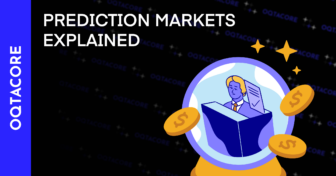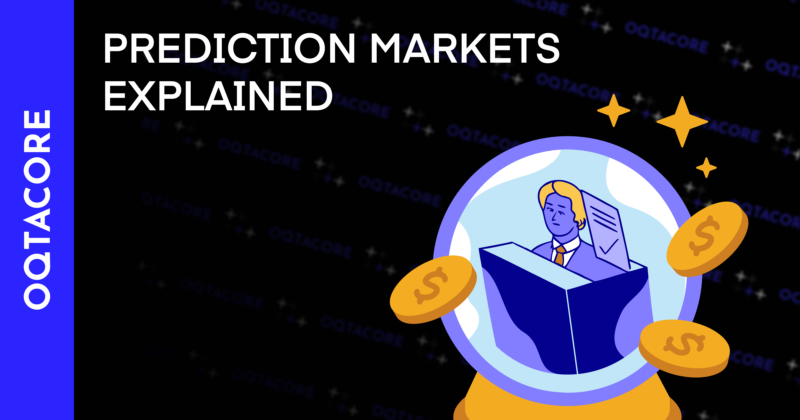
Let’s explore how prediction markets work, their transition from entertainment to serious finance,
Is predicting the future fantastic? Web3 prediction markets have proven otherwise.
For example, Polymarket predicted in advance almost all the states that Trump would win in the last election, proving that blockchain technology is far more accurate than traditional analysis methods. Forget about crystal balls, soothsayers, and corrupt media – it’s the blockchain where the real predictions are being made these days!
This article will explore the fascinating world of prediction markets, learning how they work, their impact, and where this narrative might be headed.
Let’s start…
A little bit of history
Since ancient times, humanity has been fascinated by predicting the future because of its inherent excitement. In Mesopotamia, people bet on the timing of seasonal floods, believing that accurate predictions could mean the difference between famine and plenty regarding agricultural yields. Early Chinese gamblers bet on the outcome of battles and harvests, linking fate with fortune.
The Dutch Tulipomania of the 17th century epitomized a speculative frenzy. Citizens gambled that the price of tulip bulbs would rise endlessly, creating one of the first economic bubbles in history. This episode showed how collective speculation can dramatically distort markets. They did put all their eggs in one basket!
During the Renaissance, European merchants and explorers bet on the success of voyages, anticipating returns on risky investments. These practices laid an early foundation for financial forecasting and insurance. Over time, they have evolved into structured markets that predict everything from commodity prices to election results. With the advent of the Internet, these markets moved into the web space, becoming Web2 prediction markets.
Today, the most popular Web2 prediction marketplaces are PredictIt and Kalshi. PredictIt is known for its focus on political events, allowing users to bet on elections, political outcomes, and legislative developments in the United States. It operates under an academic exemption from the Commodity Futures Trading Commission (CFTC), giving it a niche presence among politically engaged users and researchers. However, this exemption limits its scale, limiting the number of participants and the amount of bets allowed.
Kalshi, founded in 2018, is another major player in the prediction market. Unlike PredictIt, Kalshi is fully regulated by the CFTC, allowing it to offer a broader range of markets, including economic indicators, weather events, and political outcomes. This regulatory approval attracts users who value security and compliance, making Kalshi stand out in a field where regulation is often murky.
The rise of Web3 prediction markets
Blockchain technology and decentralized finance have revolutionized prediction markets, giving rise to Web3 platforms. These new markets are decentralized, allowing participants to bet on real-world outcomes—from elections to financial trends—turning predictions into market-based forecasts.
Participants use cryptocurrency to buy shares in different event outcomes, and the prices show how likely each outcome is thought to be. When the event ends, those who chose the correct outcome get their original bet back plus a profit, while others lose their bet. This setup, where someone wins and someone loses, gathers opinions from many people, making these platforms useful for areas like politics, sports, and technology by providing valuable insights.
Web3 prediction markets offer several advantages over their centralized web2 counterparts. Operating on decentralized networks eliminates the need for central authorities, reducing the risks of manipulation and censorship. The cryptographic foundations of blockchain provide enhanced security, while its open ledger ensures transparency, fostering trust and accountability. Furthermore, smart contracts automate processes, minimizing intermediaries and boosting efficiency – think of them as tireless workers who execute without pause.
Accessibility is another key feature — anyone with an internet connection can participate, bypassing traditional barriers, even in regions where gambling is restricted. As demand for accurate, data-driven predictions grows, Web3 prediction markets are carving out a unique space in decentralized finance. They combine the crowd’s wisdom with blockchain’s power to create a secure, transparent, and engaging way to forecast the future.
With the global gambling market predicted to approach $1 trillion by 2030, Web3 prediction markets could become more than just a part of the crypto narrative.
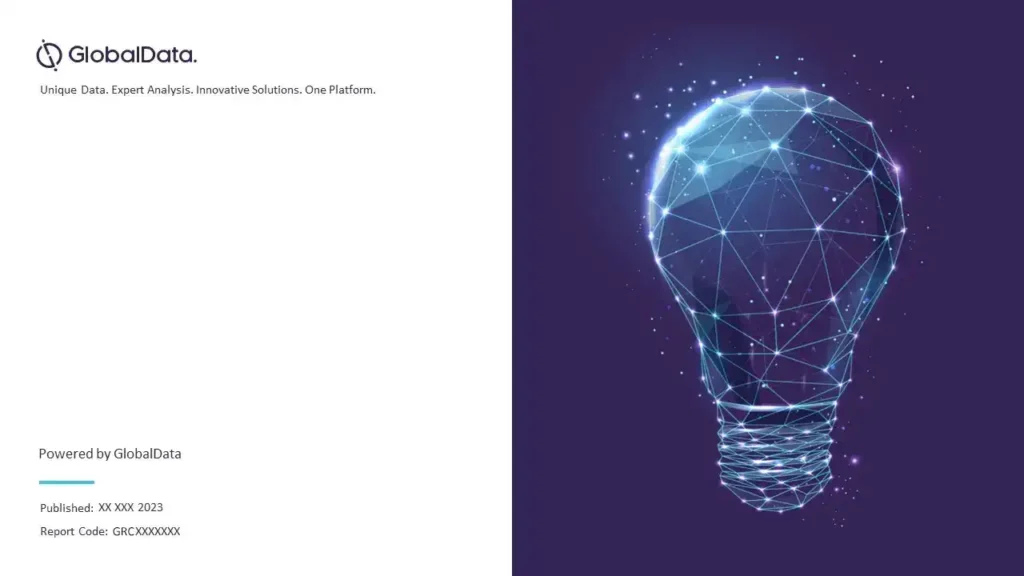
The Operational Mechanisms of Prediction Markets
Prediction markets work in stages and can be divided into five steps:
- Step One: Market creation involves a user asking about a future event, such as “Will cryptocurrency X reach $10,000 by the end of the year?” This is established on the blockchain via a smart contract, which defines the event’s parameters and possible outcomes.
- Step two: Liquidity provision requires users to deposit tokens to provide liquidity, ensuring enough assets for smooth trading. Liquidity providers can earn fees or rewards, incentivizing their participation.
- Step Three: Trading shares allows participants to buy or sell shares representing different outcomes. Share prices fluctuate based on supply and demand, reflecting the market’s collective probability for each result.
- Step Four: Event Resolution takes place after the event. A decentralized oracle, with a special mechanism to control and input data from the real world, verifies the actual result and passes it to the smart contract for calculation, providing a transparent and tamper-proof solution.
- Step Five: Payout Distribution occurs when the smart contract automatically calculates winnings based on the correct outcome. Holders of correct prediction shares receive payouts proportional to their holdings.
The Flywheel Effect
Decentralized prediction markets benefit from a self-reinforcing flywheel effect. Increased user participation enhances liquidity and market depth, attracting more users. As participation grows, prediction accuracy improves by leveraging the crowd’s collective wisdom. This heightened accuracy makes the markets even more appealing, perpetuating the cycle.
This momentum strengthens the market’s utility and credibility, fostering an environment where collective insights lead to more reliable and efficient forecasting.
Classification of Web3 Prediction Markets
Due to technological advancements and evolving user needs, Web3 prediction markets have diversified. They can be classified by technical design, event focus, user engagement, token use, business models, and growth strategies.
Let’s take a glance at classification:
Technical Design: Early platforms used blockchain-based order books, which faced scalability challenges. To improve user experience, some platforms adopted automated market makers (AMMs) with constant product formulas, simplifying trades and ensuring continuous liquidity. Others use a peer-to-pool model, offering shared liquidity across multiple markets, reducing users’ complexity.
Event Focus: Platforms differ in event focus. Some specialize in high-profile political or news events, attracting users during significant events like elections. Others focus on sports and recurring events, encouraging ongoing user engagement.
User Engagement: Platforms focused on major events see sporadic engagement, while those with recurring events build a loyal user base, fostering consistent activity and a strong community.
Token Use: Some platforms use native tokens to align incentives and reward participation, while others operate without tokens, focusing on simplicity and lowering entry barriers for new users.
Business Models: Platforms vary in their business approaches. Some target individual users or business-to-consumer models with user-friendly interfaces. In contrast, others partner with businesses, offering white-label solutions or integrating prediction markets into existing business-to-business services.
Growth Strategies: While some platforms seek to expand by diversifying their markets and supporting more blockchain networks, others focus on technical aspects such as increased liquidity and improved design architectures.
The current ecosystem of prediction markets
The Web3 prediction marketplace has evolved into a robust ecosystem that has grown sixfold since the beginning of 2024.
There are already more than 30 working Web3 platforms, and more are in development. Let’s examine the most popular services.
Polymarket
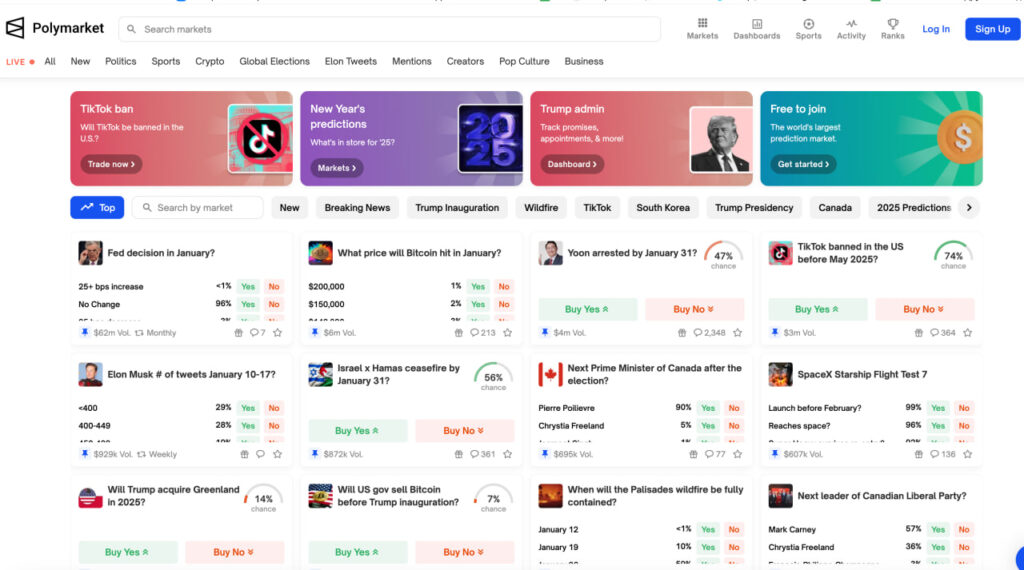
Polymarket, launched in 2020 on the Polygon network, dominates the sector with a TVL of $116 million – over 76% of the industry’s total. Transitioning from an automated market maker model to an order book system, Polymarket enhances price discovery by allowing users to place bids and asks directly. It uses UMA’s Optimistic Oracle for dispute resolution, with UMA token holders acting as impartial judges in the event of disagreements.
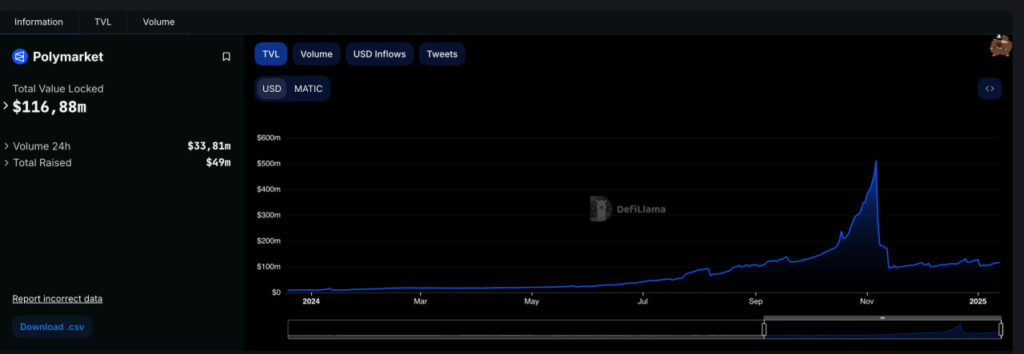
Polymarket focuses heavily on political events, particularly the last US election. The trading volume on Polymarket for the presidential election reached a staggering $3.6 billion. Plans include diversifying market categories and introducing PolyLend, a peer-to-peer lending protocol that enables users to borrow against their conditional token positions.
Polymarket has raised $74m in three fundraising rounds. More recently, the team announced plans to release its native token.
Azuro
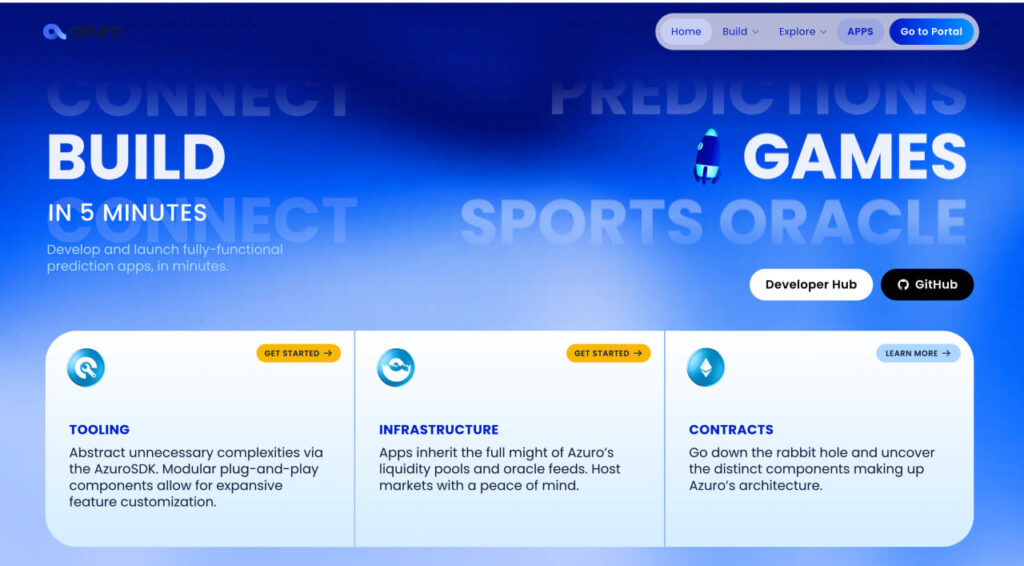
Azuro offers an innovative peer-to-pool model where liquidity providers act as the house, pooling funds across multiple markets to improve capital efficiency and risk diversification. Operating on Polygon, Gnosis Chain, and Chiliz, Azuro primarily focuses on sports betting, with football events accounting for 58.4% of its volume. Since its launch, it has facilitated over $200 million in prediction volume and processed over 5.8 million transactions.
With over 30,000 bettors and the most returning users, the platform shows strong user engagement. Azuro aims to expand into social and political events, decentralize its governance and dispute resolution mechanisms, and allow anyone to launch prediction applications without upfront costs, tapping directly into its liquidity pools.
Gnosis
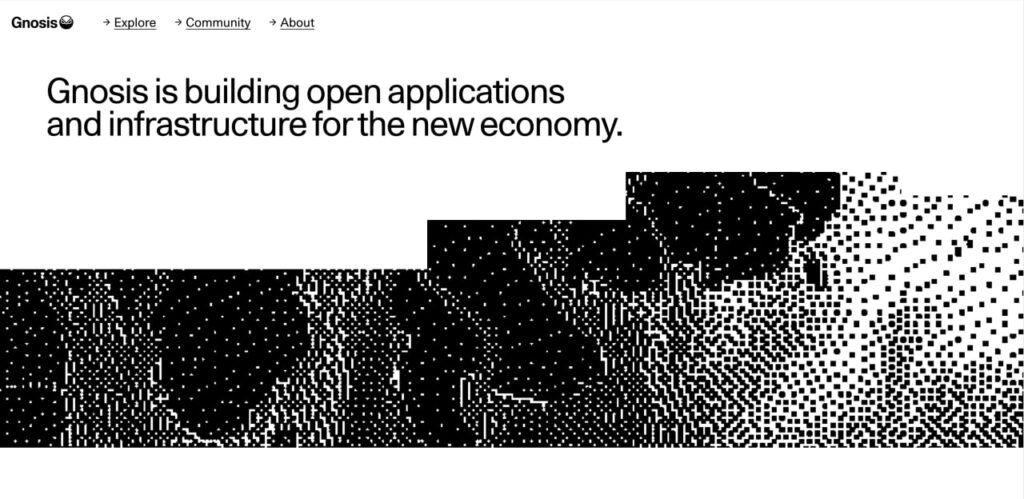 Gnosis is a pioneering platform extending prediction markets to decentralized trading and wallet services. Founded in 2015 by Martin Köppelmann and Stefan George, Gnosis Conditional Token Framework to tokenize outcomes and employs its native token, GNO, for governance and staking.
Gnosis is a pioneering platform extending prediction markets to decentralized trading and wallet services. Founded in 2015 by Martin Köppelmann and Stefan George, Gnosis Conditional Token Framework to tokenize outcomes and employs its native token, GNO, for governance and staking.
Its use of decentralized oracles and emphasis on enhancing user experience through intuitive interfaces have made it a notable player. Gnosis appeals to users interested in various blockchain applications, offering a comprehensive ecosystem that supports multiple use cases.
The Impact of Web3 Prediction Markets on the Recent Election
Web3 prediction markets significantly impacted perceptions and outcomes in the US presidential election this autumn. The Democratic Party nominated Kamala Harris, who favors higher taxes, tighter cryptocurrency regulation, and a gradual reduction in the Fed Funds rate – a policy that implies a strong dollar in the future.
The Republicans nominated Donald Trump, who promised a Fed rate cut shortly. This resulted in a “cheap dollar,” the active development of the US as a global crypto hub, and various populist measures.
Traditional and prediction markets initially categorized the race as a dead heat at 50-50. However, in early October, Trump’s odds on Polymarket climbed sharply, shifting to a 60-40 advantage. Media outlets criticized Polymarket for deviating from accepted models, alleging bias and manipulation.
Crypto enthusiasts conducted an on-chain investigation and discovered that a user nicknamed “Fredi9999” and related accounts PrincessCaro, Michie, and Theo4 had placed over $26 million on Trump’s victory in one week. Analysts concluded these accounts belonged to one individual, possibly from France. The media speculated about possible manipulation and interference by Trump and his team.
Journalists from The Wall Street Journal interviewed the elusive “Monsieur Whale,” revealed to be a French trader formerly connected to major financial institutions. He claimed his substantial bets were purely economic, believing traditional markets underestimated Trump’s chances.
With the election concluded, we can now objectively analyze the situation. While mainstream media delayed announcing results and maintained suspense, decentralized prediction markets like Polymarket promptly provided accurate forecasts. By midnight on November 6, Polymarket showed a clear advantage for one candidate, reflecting voter sentiments that traditional polls missed. The FBI even opened an investigation and seized the Polymarket CEO’s phone and electronics after the platform predicted Trump’s victory.
Despite criticism, Polymarket proved effective—prominent financial players, including JPMorgan and leading hedge funds, utilized data from this platform. The trading volume on Polymarket for the presidential election reached $3.6 billion, incentivizing participants to make accurate predictions.
Web3 prediction markets operate independently of participants’ ideologies and strive for accuracy. They account for errors in traditional polling methods, adjust pricing in real-time, and react swiftly to new information free from biases. This election demonstrated that decentralized platforms outperform traditional analytics by providing more reliable predictions.
Perhaps the only prediction Polymarket missed was just how astonished traditional markets and media would be once again when outpaced by crypto enthusiasts!
From Prediction Markets to Info Finance
Building on the transformative impact of Web3 prediction markets, especially in recent elections, we are now witnessing the dawn of a new paradigm in the information economy: Information Finance. In a world overflowing with data but often lacking clarity, Information Finance represents an evolution in how we use collective intelligence to make decisions—originally proposed by Ethereum co-founder Vitalik Buterin, Information Finances beyond traditional markets. It aims to build mechanisms meticulously designed to extract valuable information, align incentives, and transform human judgment into actionable insights.
Where traditional markets simply react to information, Info Finance constructs systems that are correct by design – deliberately engineered to extract precise knowledge from participants. This ensures that outcomes are more reliable and less prone to bias. Imagine a marketplace designed for trading assets and optimizing the flow of insights and knowledge.
This concept creates a three-sided market:
- In the first corner are Predictors: People who make predictions based on their insights.
- In the second corner are consumers, who seek forecasts to inform their decisions.
- The last corner is the market mechanism: platforms that aggregate and process predictions, treating them as a public good optimized for accuracy.
Imagine it as an orchestra: predictors are the musicians bringing their unique notes, consumers are the audience eager to experience the performance, and the market mechanism is the conductor who ensures everything comes together in harmony. Together, they create more than just sound – a symphony of collective insight, where every part contributes to a greater understanding.
Use Cases of Info Finance
The transformative potential of Info Finance spans multiple domains:
The first is governance and community: Decentralized Autonomous Organizations, or DAOs, often suffer from voter fatigue – too many proposals, too little engagement. Info Finance predicts voting outcomes and reserves actual votes for critical issues, making decision-making more efficient while upholding democratic principles. For example, a DAO managing community funds could use Info Finance to highlight the most likely consensus proposals and focus efforts on the most impactful initiatives.
The second is public goods funding, which often suffers from popularity bias. Info Finance identifies and supports initiatives based on true value, ensuring that resources go to impactful projects, not just the most visible. Imagine markets using collective judgment to fund infrastructure projects based on societal impact rather than flashy marketing.
The third is talent discovery and personal tokens. Personal tokens can be volatile and speculative, but information finance is refining these models to reflect individual potential better. This could lead to prestige futures—structured investments in someone’s future success, helping emerging artists or scientists gain resources while rewarding supporters.
Finally, scientific research and peer review: Info finance can help address the replication crisis by predicting the replicability of studies and directing research funding to the most promising work. Imagine funding decisions based not just on peer review but on market-based predictions of which studies will likely be scrutinized.
The Issue of Trust and Acceptance
Info Finance emerges as a means to rebuild consensus and collective wisdom in an age of information overload and eroding trust. By balancing market mechanisms — efficient engines of information aggregation — with trusted institutions that provide legitimacy, this synergy enhances decision-making and transforms how we harness information.
Key enablers making Info Finance both feasible and effective:
- Create transparent mechanisms that focus on incentives for participants: By incentivizing participants to provide accurate information, these mechanisms build trust and ensure the entire platform’s reliability and efficiency.
- Leverage blockchain technology: Technological advances have eliminated previous concerns about speed and cost, providing a solid foundation for fast and cost-effective info information finances.
- AI integration: Artificial intelligence improves operational efficiency by easily analyzing large data sets and solving complex problems. When integrated with InfoFinance resources, it results in an advanced and feature-rich system.
Conclusion
The fascinating journey of Web3 prediction markets and their evolution into information finance reflects the natural progression of the entire DeFi landscape. Prediction markets are about predicting outcomes and transforming how we collect, process, and use information. By integrating cutting-edge technologies, prediction markets have already given us a more accurate world understanding.
But what does that mean for us? It means better forecasting for businesses and medicine, more political transparency, and the opportunity to participate in a global, decentralized effort to understand the future. Imagine financial mechanisms that don’t just move money but actively help us understand the world. The promise of decision-making lies not in more data but in smarter markets that know which questions to ask and reward those who answer them well.
READ OTHER ARTICLES:
